Top speed 560 km/h Cruise speed 530 km/h Length 25 m | Wingspan 29 m Weight 12,250 kg | |
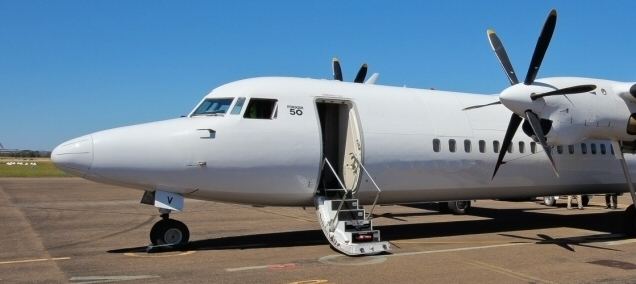 | ||
Engine type Pratt & Whitney Canada PW100 | ||
Fokker 50 vlm airlines take off at bern airport
The Fokker 50 is a turboprop-powered airliner, designed as a refinement of and successor to the highly successful Fokker F27 Friendship. The Fokker 60 is a stretched freighter version of the Fokker 50. Both aircraft were built by Fokker in the Netherlands. The Fokker 60 has been operated by the Royal Netherlands Air Force (RNLAF), ex-RNLAF aircraft are also in service with the Peruvian Naval Aviation and the Republic of China's Air Force.
Contents
- Fokker 50 vlm airlines take off at bern airport
- Fokker 50 denim air landing take off at bern airport
- Fokker 50
- Fokker 60
- Design
- Operators
- Fokker 50 civil operators
- Fokker 50 military and government operators
- Former operators
- Fokker 60 military operators
- Accidents and incidents
- Specifications series 100
- References
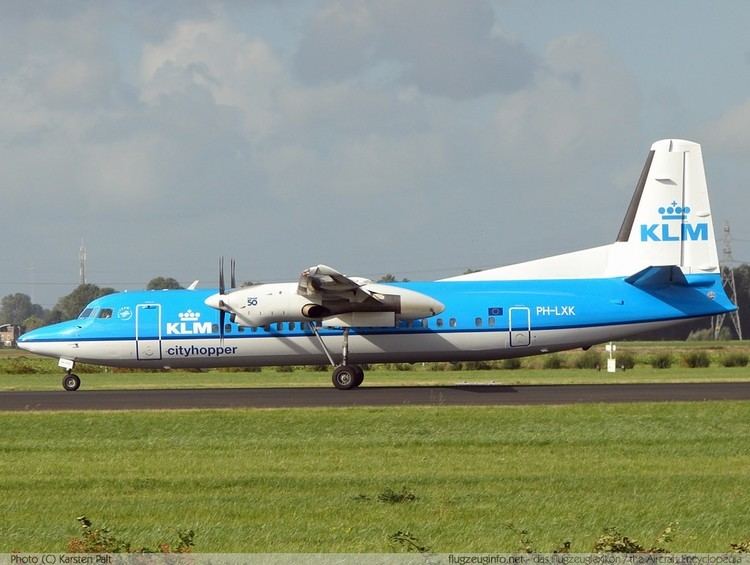
Fokker 50 denim air landing take off at bern airport
Fokker 50
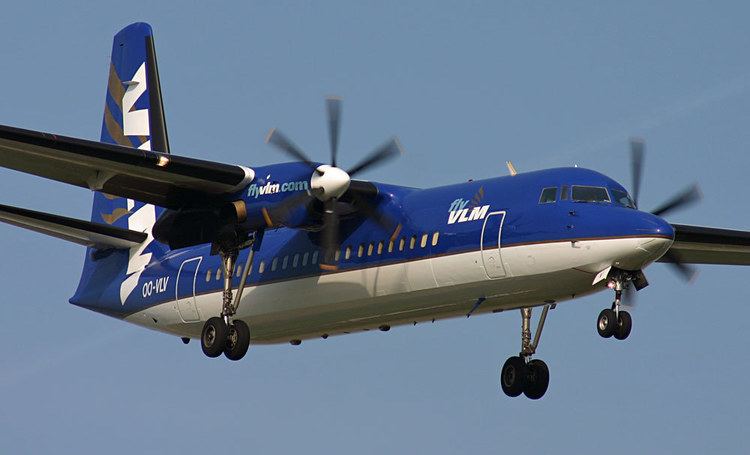
The Fokker 50 was designed after sales of the Fokker F27 Friendship, which had been in continual production since 1958, were beginning to decline by the 1980s. Design of the Fokker 50 started in 1983, with DLT and Ansett Airlines of Australia being launch customers.
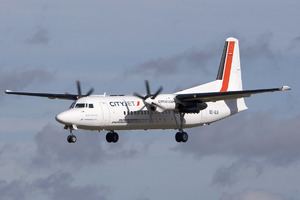
Fokker built two prototypes derived from F27 airframes, the first of which flew for the first time on 28 December 1985. Certification of the Fokker 50 by the Dutch aviation authority RLD was successfully completed in 1987 and the first production aircraft was delivered to DLT of Germany. Production ended in 1996 after the Fokker Aircraft Company went into liquidation, with the last aircraft delivered the following year. By the end of the program, 213 Fokker 50s had been produced. As of August 2006 a total of 171 Fokker 50 aircraft remained in airline service. Major operators included: Avianca (10), Denim Air (12), Skyways Express (18) and VLM Airlines (20). Some 27 other airlines including Air Astana also operate smaller numbers of the type.
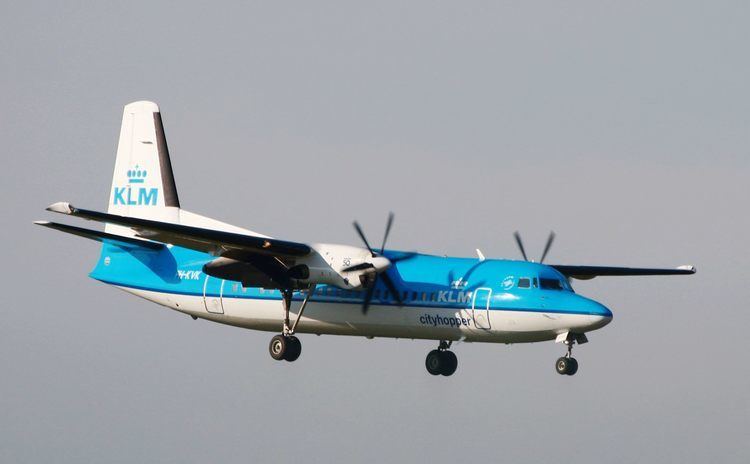
Since March 2013, two Fokker 50s are based at EHLE Lelystad airport in their Royal Netherlands Air Force livery. Both have been purchased by the Peruvian Navy and will depart before the end of September 2014.
Fokker 60
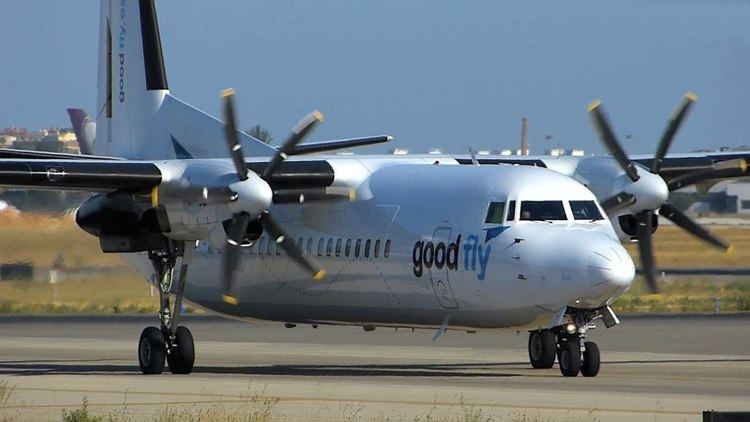
The Fokker 60 is stretched 1.62 m (5.31 ft) longer than the F50 for a total length of 26.87 m (88.16 ft). It has a large cargo door on the right side immediately behind the cockpit. Only four examples were built, all of them delivered to the Royal Netherlands Air Force. All of them were part of 334 Squadron based at Eindhoven Airport. They were used to transport equipment and soldiers. Paradrops were done as well. Another 60 were under construction but never completed, due to Fokker's bankruptcy. Two of the Fokker 60s (U-01, U-03) were converted in 2005 to Maritime Patrol aircraft as a temporary solution when the Royal Netherlands Navy P-3 Orions were phased out due to budget cuts. They were stationed at Hato AB Curaçao, until they were replaced by civil DHC-8 aircraft in October 2007. When the Royal Netherlands Air Force decided to buy two extra Lockheed C-130s, the Fokker 60s were phased out. The four Fokker 60 that were stored at Woensdrecht Air Base were sold to the Peruvian Naval Aviation, the first two planes were delivered on 8 June 2010 and the second batch of two planes are delivered at the end of 2010.
Design
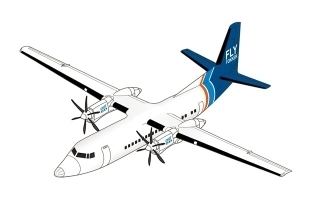
The Fokker 50 was based on the stretched F27-500 airframe, but with a larger number of smaller windows in the fuselage and a two-wheel nose gear.
Basic construction of the fuselage, wings and empennage (tail) remained unchanged apart from strengthening the various sections where required. The wing was equipped with upturned ailerons and wingtips, effectively acting as wing endplates or winglets.
The major design change from the Fokker F27 was in the engines, and in equipping the aircraft with an electronic flight and engine-management system. The original Rolls-Royce Darts in various marks of basically 1,268-1715 kW (1,700-2,300 hp) were replaced with two more fuel efficient Pratt & Whitney Canada PW124 powerplants of 1,864 kW (2,500 hp) each, driving six-bladed Dowty Rotol propellers.
The Fokker 50 can carry up to 62 passengers over a range of 1,080 nm (1,243 mi, 2,000 km ) at a typical speed of 286 knots (530 km/h 329 mph), a 27 knots (31 mph, 50 km/h ) increase over the Fokker F27.
Although of being a previous generation design, it is highly appreciated by owners & pilots for its reliability, economics and flight characteristics.
Fokker 50
Fokker 60
Operators
As of October 2012 124 aircraft were still in operational use with airlines.
Fokker 50 civil operators
Uploaded 23 February 2016. Only operators with 5 units or more.
Iranian Naft Airlines (6)
Fokker 50 military and government operators
The following governments or military operators currently fly the Fokker 50 in passenger or cargo roles:
Former operators
Fokker 60 military operators
Former operators
Accidents and incidents
Specifications (series 100)
Data from airlines.net
General characteristics
Performance
Armament
two × AGM-84D Harpoon missiles and radar, sonar systems (Republic of Singapore Air Force Fokker 50s)
